Alaska Fish & Wildlife News
March 2023
Helping Sea Lions
"Lose the Loop"
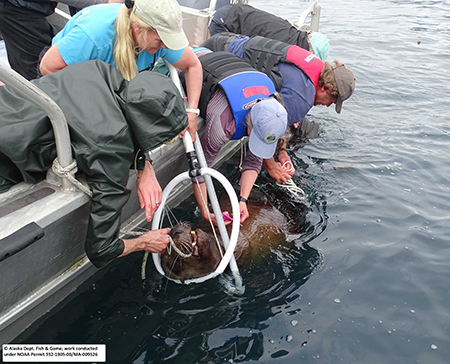
Young Steller sea lions are curious and playful, which can get them into trouble with marine debris. Loops are particularly dangerous – those hard plastic packing bands that secure bait boxes and luggage, big rubber bands used with crab pots, loops of rope and things like fan belts. Pups and juveniles toss them around and swim with them, and the loops get caught around their necks. As they grow, the band cuts more deeply and eventually can kill the animal.
Lauri Jemison is a state wildlife biologist focusing on marine mammals. Much of her work over the past two decades has been with Steller sea lions, and she’s been on dozens of trips involving captures, resighting marked animals, and documenting sea lion movements. She’s seen plenty of sea lions in trouble: tangled in netting, hooked in fishing gear, and one had a tire stuck around its neck. Close to 900 sea lions in the waters of Southeast Alaska have been documented with entanglements; about half of those have interacted with floating debris in the water and ended up with loops around their necks; the other half involved fishing gear. For more than 20 years, Jemison has worked closely with colleagues Kim Raum-Suryan and Dr. Kate Savage from the National Marine Fisheries Service (also known as NOAA Fisheries) documenting and trying to reduce Steller sea lion entanglements.
In the past, entangled animals were almost certainly doomed to a slow, agonizing death. It was almost impossible to capture a large juvenile or adult sea lion and cut the entanglement free. Sedating a marine mammal is risky; it is best done when the animal is hauled out on land – and in the past, if a darted animal went in the water as the drug was taking effect there was a high risk of drowning. But the development of new drugs, and years of fine-tuning capture techniques has made it possible today to sometimes help entangled sea lions.
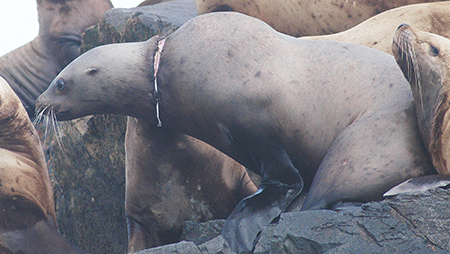
When they consider taking action to remove an entanglement, Jemison said they prioritize animals with a human-caused, life-threatening issue. Then they evaluate the conditions and the site.
“Can we safely approach the animal, dart it, and recover the animal if it goes in the water,” she said. “We need calm conditions, no strong winds, no kelp - which can look like a sea lion nose sticking up. We can’t work in an area with strong currents, for the animal’s safety and our safety.”
The new drug combination was developed about 15 years ago by researchers with the University of British Columbia, the Marine Mammal Center, and the Vancouver Aquarium, working with other veterinarians. “They were having a lot of success with the new drug combination down south, so we tried it in Southeast Alaska on three adult females, and it went really well,” she said.
She describes the sea lions as sedated, but they retain their breathing reflex. “That’s the big thing. They breath at the surface but they still dive, which is really unnerving. They’ll dive down and blow out a large volume of air, then come back up, and just sort of drift along with their head out of the water, nose pointing up, swimming slowly, sort of half sleeping but functioning.”
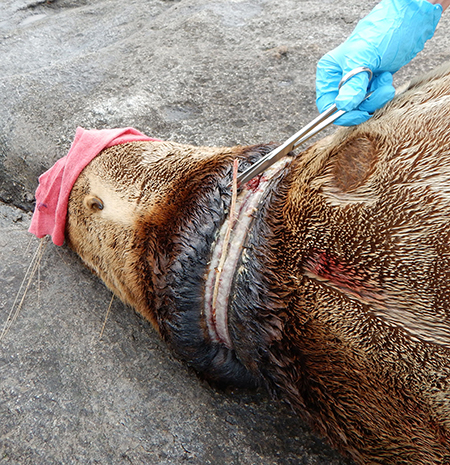
Jemison, Raum-Suryan, and Savage have conducted about a dozen entanglement responses. Sea lions are highly social and gather in large numbers on beaches and rocky outcrops known as haul outs. A team of biologists work in three groups. Usually, two teams are in skiffs offshore, ready to move in if the animal goes in the water – which happens about half the time. The on-shore group includes a veterinarian that does the darting, and sneaks up on the entangled animal from the cover of the woods, or by crawling behind boulders and beach logs.
“We try to work during a low and falling tide, because we want the target animal as far from the water’s edge as possible,” Jemison said. “We’ve had our best luck keeping an animal on shore when there’s more distance between the animal and the water. We usually dart the entangled animal from the woods or while hiding behind a boulder. Generally, when an animal is hit with the dart it’ll sit up, look around, move a few steps toward the water, and then lay down.”
That’s the best-case scenario. When that happens, the biologists are looking at a sedated (but not completely unconscious) sea lion on a boulder-strewn beach among a group of juveniles, sub-adults, and 700 to 2,000-pound adults.
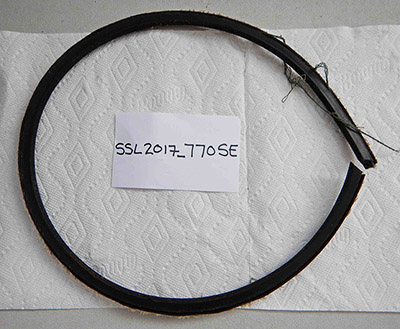
“We slink up to the target animal very slowly and move the nearby animals away as slowly and carefully as possible,” Jemison said. “We don’t want to stampede 100 animals into the water, along with our darted animal. Once an animal is sedated, the first thing we do is cut the entanglement off, and then we take samples and measurements, and glue a satellite tag on to the fur. Lately we’ve been attaching satellite flipper tags as well. The satellite tags allow us to track the fate of the disentangled animal.”
Jemison recalled a less-than-best-case encounter when a group of sea lions spooked right after the team sedated an adult male.
“We had darted him and everything went great,” she said. “He was laying there by the water’s edge and an eagle flew over I think - something spooked the animals and they went in the water, some of them climbing over the sedated animal to get into the water. This aroused the sedated animal and he went into the water but remained close to shore and with all of the other animals milling around him it was impossible to retrieve him. Eventually the sedated animal moved off shore and we followed him for over an hour but he was not sedated enough to handle and so we couldn’t disentangle him. It was good to see that he continued to breathe, and eventually he fully recovered from the drugs.”
Another time they successfully darted a sub-adult male sea lion that had a fan belt around its neck. Then things got weird.
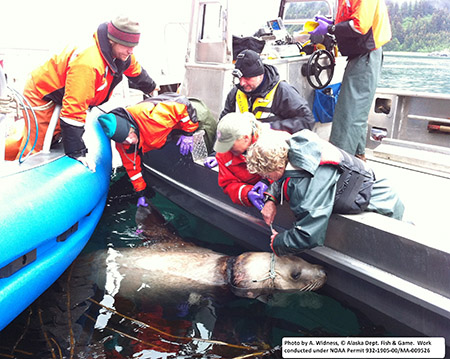
“He was on shore and Kate darted him from the woods,” Jemison said. “He moved to the water’s edge, laid down, but then got up and went into the shallows. We had two people on shore, and two or three boats in the water, all watching our sedated animal. Then a large male swam over and pushed him further from the shore and then laid on top of him, sort of smothering him, holding him under the water. We’d never seen this behavior before and we were not at a rookery where we’d expect males to be more belligerent. Kim and I were together in a skiff and we had to maneuver among about 50 animals in the water to get near the sedated male. Luckily our approach scared off the aggressive sea lion, otherwise there was a good chance the sedated animal would have drowned. Eventually we ended up cutting a fan belt from the animal’s neck.”
Lose the Loop
Marine scientists all over the world are working on this issue. In 2009, Jemison, along with Raum-Suryan, Savage, and NOAA’s Mike Williams - formed the Pinniped Entanglement Group (PEG), which has grown from those four members to more than 160 members in 18 countries.
“Our focus is prevention – lose the loop,” Jemison said. “We have subgroups addressing different issues like packing bands – how to develop a biodegradable packing band, best practices for entanglement response, we talk about advances in disentanglement work, keeping plastics out of the ocean, and reducing single-use plastics.”
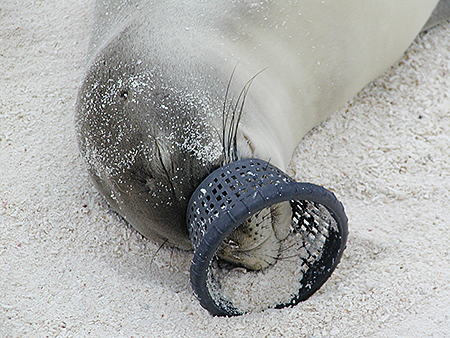
The group shares information and progress through biannual newsletters and video conference calls. Members include scientists who work with fur seals in Australia, gray seals and harbor seals in waters off the Eastern U.S., the Netherlands and the UK, cape fur seals in Namibia, California sea lions along the West Coast and in Mexico, monk seals in Hawaii, and Steller sea lions in Alaska.
Entanglement issues around the world are similar – floating plastics (rope, nets, bands – any type of loop is dangerous), fishing hooks and gear, fishing line, and nets – but some items stand out in certain regions. In Hawaii’s waters, a particular piece of fishing gear is a problem – round, conical plastic rings used in traps to catch hagfish and eels. These “eel trap entrances” are caught on the snouts of monk seal pups and even the rostrum of a bottlenose dolphin.
On the central Oregon Coast, heavy-duty black rubber bands were identified in a study (co-authored by Kim Raum-Suryan) as the most common sea lion entanglement material, observed in almost two-thirds of all entanglements and encircling the neck. These are big diameter, inch-wide loops (sometimes cut from tire innertubes) commonly used in commercial Dungeness crab pots. Those ubiquitous plastic packing bands were also a big problem, basically the other third of the entanglements. They are the most common neck entanglement found on Steller sea lions in Southeast Alaska, northern British Columbia and northern Washington; they rank high on lists of marine mammal entanglements around the world.
Ocean Guardians
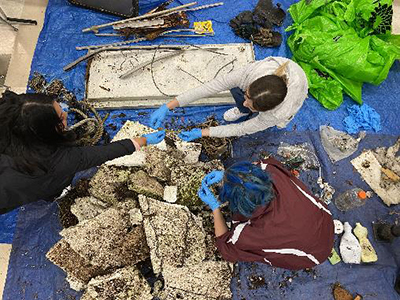
Kim Raum-Suryan serves as the current coordinator of the Pinniped Entanglement Group. She’s a biologist and a marine mammal specialist with the National Marine Fisheries Service, based in Juneau, and has worked with Steller sea lions and other marine mammals for decades. She also serves as the Alaska Regional Coordinator of NOAA’s Ocean Guardian School Program, which is managed by NOAA's Office of National Marine Sanctuaries.
The program started in the 2009-2010 school year in California, and Raum-Suryan learned about it a few years later from a documentary called "Plastic is Forever" made by a then 12-year old boy named Dylan D'Haeze. She asked around and said no one at the Alaska regional office was familiar with the Ocean Guardian Program.
“I contacted the director, Seaberry Nachbar, and she was really excited to get the program to Alaska,” she said. “My boss at the time, Jon Kurland, said that we could pilot it with two schools, even though it was completely outside the scope of my regular job duties, and here we are almost five years later with six schools and many more schools interested in the program. It is an amazing program and the kids are such an inspiration.”
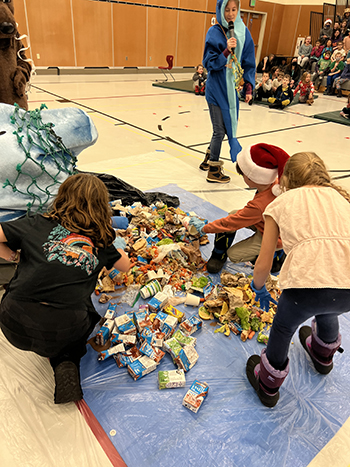
Four of the Ocean Guardian schools are in Juneau, one is in Anchorage, and one is in Ketchikan. Students at Dimond High School in Anchorage started a school-wide recycling program and cleaned up hundreds of pounds of trash from the community and from a coastal area near Whittier.
Raum-Suryan said schools pick one or more of five project pathways, collecting measurable data so they know where they started and how much progress has been made during the year (waste audits are a big hit), they do outreach, write letters, clean up the community and beaches, compost, recycle, and much more.
Applications for the program open April 1st, and funding is available for projects.
“The teachers are the champions for taking this on when they already have so much to do, but they seem to love it,” she said.
More on the Pinneped Entanglement Group
More on Marine Mammal Entanglements
Video: Entanglement of Steller Sea Lions in Marine Debris: Identifying Causes and Finding Solutions
Subscribe to be notified about new issues
Receive a monthly notice about new issues and articles.
